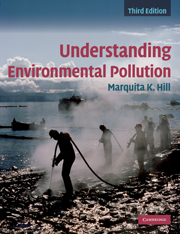Book contents
- Frontmatter
- Contents
- Preface
- Acknowledgements
- List of abbreviations and acronyms
- 1 Understanding pollution
- 2 Reducing risk, reducing pollution
- 3 Chemical toxicity
- 4 Chemical exposures and risk assessment
- 5 Air pollution
- 6 Acid deposition
- 7 Global climate change
- 8 Stratospheric ozone depletion
- 9 Water pollution
- 10 Drinking-water pollution
- 11 Solid waste
- 12 Hazardous waste
- 13 Energy
- 14 Persistent, bioaccumulative, and toxic
- 15 Metals
- 16 Pesticides
- 17 Pollution at home
- 18 Zero waste, zero emissions
- 19 Chemistry: some basic concepts
- Index
- References
4 - Chemical exposures and risk assessment
Published online by Cambridge University Press: 05 June 2012
- Frontmatter
- Contents
- Preface
- Acknowledgements
- List of abbreviations and acronyms
- 1 Understanding pollution
- 2 Reducing risk, reducing pollution
- 3 Chemical toxicity
- 4 Chemical exposures and risk assessment
- 5 Air pollution
- 6 Acid deposition
- 7 Global climate change
- 8 Stratospheric ozone depletion
- 9 Water pollution
- 10 Drinking-water pollution
- 11 Solid waste
- 12 Hazardous waste
- 13 Energy
- 14 Persistent, bioaccumulative, and toxic
- 15 Metals
- 16 Pesticides
- 17 Pollution at home
- 18 Zero waste, zero emissions
- 19 Chemistry: some basic concepts
- Index
- References
Summary
“Ordinary risk analysis asks, How much environmental damage will be allowed? But the precautionary principle asks, “How little damage is possible?”
Thomas Prugh, WorldWatch InstituteHow can we decide what is or is not safe? How much ozone should we allow in the air that we breathe? How much arsenic in drinking water is safe? What level of dioxin in soil or food is acceptable? These and similar questions regularly arise. Because we seldom have the luxury of answering “zero,” we must determine what level above zero is safe or essentially safe. The useful albeit imperfect tool of chemical risk assessment assists us in this effort.
Section I of this chapter points out that a chemical cannot be a risk unless there is exposure to it. Also discussed are body burdens. Section II reviews epidemiological studies – investigations designed to detect relationships between exposure to a chemical and adverse health effects. Section III introduces the four steps of chemical risk assessment, both for chemicals that do not cause cancer and for carcinogenic chemicals. Section IV briefly examines risk assessment for non-humans and in less-developed countries. Section V explores what practices are used to reduce a chemical's risk, risk management. These include non-regulatory as well as regulatory approaches. Section VI looks at how chemical risk assessment is changing and how the regulation of chemicals may also be changed.
- Type
- Chapter
- Information
- Understanding Environmental Pollution , pp. 89 - 116Publisher: Cambridge University PressPrint publication year: 2010

